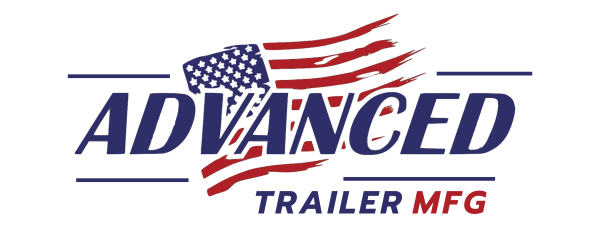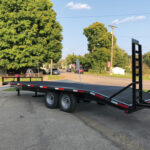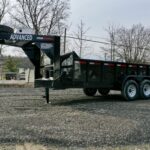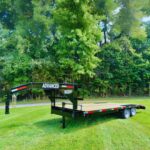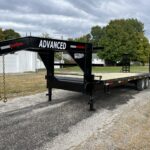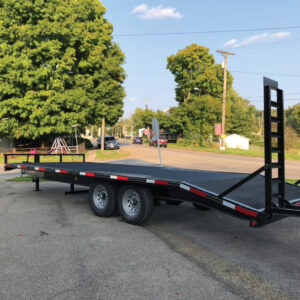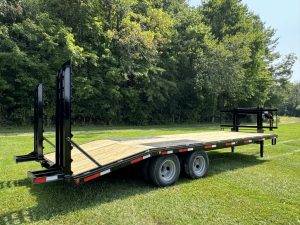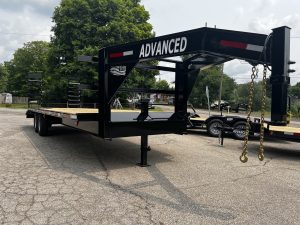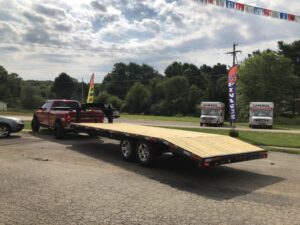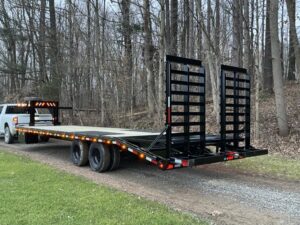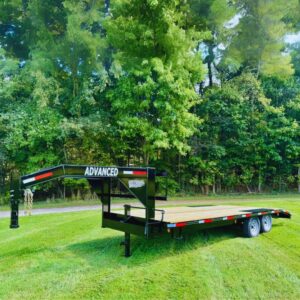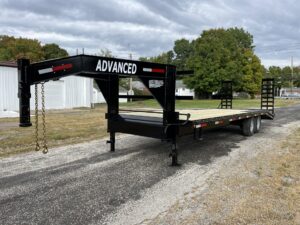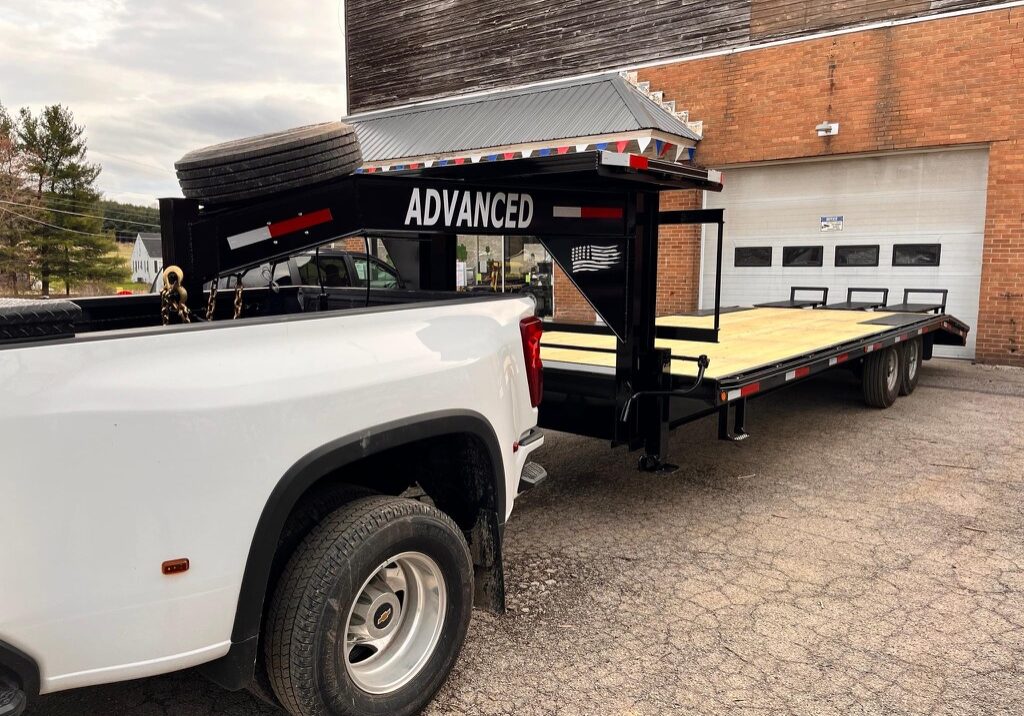
Gooseneck or Bumper Pull: Which Trailer is Best for You?
Trying to choose between a gooseneck or bumper pull trailer? This article explains the differences and helps you decide which is best for your needs.
Key Takeaways
- Bumper pull trailers are suitable for lighter loads and are easier to use, making them ideal for first-time trailer owners.
- Gooseneck trailers, with their higher weight capacity and better stability, are preferred for heavy-duty hauling and commercial applications.
- Choosing the right trailer requires assessing your towing vehicle’s capacity and your specific hauling needs to determine which type best fits your requirements.
Understanding Trailer Types
When it comes to towing, two primary trailer types dominate the market: bumper pull and gooseneck trailers. These two options differ significantly in their hitching systems, design, and functionality, each offering unique benefits and challenges.
These differences play a significant role in choosing the appropriate trailer for your needs.
What is a Bumper Pull Trailer?
A bumper pull trailer connects to a tow vehicle via a ball hitch on the rear frame, a common setup that makes these trailers popular for light to medium-duty hauling. The trailer’s tongue fits onto the ball hitch, which is typically mounted on the tow vehicle’s bumper. First-time trailer owners and those with limited trailering experience often favor this straightforward connection method. Bumper pull trailers are generally smaller and use a standard ball hitch, which means they can be towed by a wide variety of vehicles, including most pickup trucks and SUVs. The trailer’s tongue fits securely, ensuring a stable towing experience.
Its simplicity allows for easy attachment and detachment, making it convenient for those who frequently switch between towing and non-towing activities. These trailers are particularly suitable for lighter loads, such as small boats, motorcycles, or garden equipment.
However, their maximum towing capacity is generally lower compared to gooseneck trailers, which can limit their use for heavier or more demanding hauls.
What is a Gooseneck Trailer?
A gooseneck trailer is designed to be towed by a pickup truck, utilizing a hitch system that is installed in the truck bed rather than on the vehicle’s bumper. The gooseneck hitch is located beneath the truck bed, directly above the rear axle, which provides a more stable and secure connection than a bumper pull hitch. Installing a gooseneck hitch is a more involved process compared to the simpler bumper pull hitch setup.
The design of a gooseneck trailer features a long, arched neck that extends over the truck bed, allowing for better weight distribution and enhanced towing stability. This design makes gooseneck trailers ideal for heavy-duty applications, such as hauling large livestock trailers, heavy machinery, or bulky loads that exceed the capabilities of bumper pull trailers, including the use of a gooseneck ball.
Additionally, the gooseneck hitch system allows for tighter turns and improved maneuverability, making these trailers a preferred choice for experienced towers and commercial use.
Key Differences Between Bumper Pull and Gooseneck Trailers
When choosing between a bumper pull and a gooseneck trailer, it’s essential to understand the key differences in their design, functionality, and suitability for various towing tasks. These differences can significantly impact your decision, depending on your specific hauling needs and preferences.
The primary distinctions between these two trailer types include hitching mechanisms, size and capacity, and towing stability.
Hitching Mechanism
The hitching mechanism is one of the most fundamental differences between bumper pull and gooseneck trailers. Bumper pull trailers connect to the tow vehicle’s rear frame using a ball hitch, which makes them easy to attach and detach. Being user-friendly, this hitch can be managed without much hassle since it is visible from the driver’s seat during attachment. This simplicity benefits those with limited trailering experience or first-time trailer owners.
Gooseneck trailers use a more complex hitching system. This system is installed in the truck bed. The gooseneck hitch is mounted above the truck’s rear axle, providing a more stable and secure connection. Although this setup provides enhanced stability, it demands more effort and precision during installation and attachment. Gooseneck hitches are essential for this type of trailer.
This hitching mechanism is beneficial for heavy-duty hauling, as it distributes the weight more evenly across the vehicle’s frame, reducing sway and improving overall towing performance with a fifth wheel hitch and a hinged plate hitch.
Size and Capacity
The size and capacity of the trailer are crucial factors to consider when deciding between a bumper pull and a gooseneck trailer. Gooseneck trailers can handle larger and heavier loads, often exceeding 30,000 pounds, making them ideal for heavy-duty applications such as transporting heavy machinery or livestock. Their design allows for better weight distribution over the truck’s rear axle, which enhances their towing capabilities and stability.
On the other hand, bumper pull trailers are generally limited in size and capacity, with a maximum load capacity significantly lower than that of gooseneck trailers. This limitation makes bumper pull trailers more suitable for lighter hauling needs, such as small boats, recreational vehicles, or garden equipment.
Knowing the specific weight and dimensions of your cargo helps determine which trailer type will best meet your needs.
Towing Stability
Towing stability is a critical consideration for anyone planning to haul heavy loads over long distances. Bumper pull trailers often struggle with maintaining stability, especially when towing heavier or unbalanced loads. They are more susceptible to sway and instability, particularly at higher speeds or during sharp turns, and this can be exacerbated by uneven terrain or windy conditions.
In contrast, the design of gooseneck trailers provides superior stability due to better weight distribution and a lower center of gravity. The gooseneck hitch configuration reduces sway and offers a smoother pull, making these trailers more stable and safer to tow, especially with heavier loads. This stability makes gooseneck trailers a preferred choice for long-distance towing and commercial hauling.
Advantages of Bumper Pull Trailers
Bumper pull trailers offer several advantages that make them a popular choice for a wide range of users. These benefits include cost-effectiveness, ease of use, and versatility, making them suitable for both recreational and commercial purposes. These advantages can be explored in more detail.
Cost-Effectiveness
One of the primary advantages of bumper pull trailers is their cost-effectiveness. These trailers are generally more affordable to purchase and maintain compared to gooseneck trailers, making them an appealing choice for first-time users and those on a budget.
Bumper pull trailers are also better suited for lighter loads, which often means lower overall costs for towing and maintenance. Bumper pulls are a practical choice for many.
Ease of Use
Bumper pull trailers are known for their ease of use, making them a popular choice for casual users and first-time buyers. They connect to the tow vehicle’s bumper via a ball hitch, which simplifies the attachment and detachment process. This straightforward hitching mechanism allows for greater maneuverability and ease of handling, especially in tight spaces.
Additionally, bumper pull trailers are versatile, capable of transporting various types of cargo, including horses, boats, and recreational vehicles. Their design results in a smoother pull and better towing stability with light-duty vehicles. This versatility and ease of use make bumper pull trailers a convenient and flexible option for many towing needs.
Versatility
The versatility of bumper pull trailers is another significant advantage. These trailers can accommodate a wide range of cargo types, making them suitable for both recreational and commercial purposes. Whether you’re hauling toys and equipment for a weekend adventure or carrying materials for your business, a bumper pull trailer can handle the job.
Their adaptability enhances their appeal to a broad audience, from hobbyists to professionals. This versatility, combined with their cost-effectiveness and ease of use, makes bumper pull trailers a practical choice for many towing applications.
Advantages of Gooseneck Trailers
Gooseneck trailers offer several advantages that make them a preferred choice for heavy-duty hauling and commercial use. These benefits include higher weight capacity, better maneuverability, and enhanced stability, which are crucial for demanding towing tasks.
These advantages can be explored further.
Higher Weight Capacity
Gooseneck trailers are renowned for their higher weight capacity, making them ideal for transporting heavy loads over long distances. These trailers can handle loads exceeding 30,000 pounds, thanks to their robust design and better load distribution across the truck’s frame.
This capability makes gooseneck trailers suitable for commercial use and heavy-duty applications, such as hauling heavy machinery or livestock.
Better Maneuverability
The design of gooseneck trailers allows for better maneuverability, especially in tight spaces. Their closer connection to the towing vehicle provides a tighter turn radius, making it easier to navigate through constrained areas. This enhanced maneuverability is particularly beneficial for experienced towers and those who frequently need to make sharp turns or navigate through crowded areas.
Enhanced Stability
Gooseneck trailers also offer enhanced stability, which is crucial for safe and efficient towing. Their design reduces the likelihood of swaying during transport, providing a smoother pull and a better ride. Additionally, gooseneck trailer slides can further improve the towing experience.
This stability is crucial for long-distance towing and carrying heavy loads, ensuring a safer and more comfortable journey.
Disadvantages of Bumper Pull Trailers
While bumper pull trailers have many advantages, they also come with certain limitations. These disadvantages include limited load capacity and stability concerns, which can impact their suitability for heavy-duty hauling tasks.
These drawbacks can be examined in more detail.
Limited Load Capacity
One of the main disadvantages of bumper pull trailers is their limited load capacity. These trailers typically have a maximum towing capacity of around 20,000 pounds, with a combined weight limit of 10,001 pounds for the trailer and the towing vehicle.
This restriction makes them less suitable for transporting heavy loads compared to gooseneck trailers.
Stability Concerns
Another significant disadvantage of bumper pull trailers is their reduced towing stability, especially when carrying heavier loads. Their hitching mechanism and design can lead to instability, particularly on rough terrain or during sharp turns, increasing the risk of sway and making them less safe for heavy-duty hauling.
In contrast, gooseneck trailers offer better stability, making them a preferred choice for those needing to transport heavier loads over longer distances.
Disadvantages of Gooseneck Trailers
Gooseneck trailers, while offering significant advantages, also have certain disadvantages. These include higher costs and space requirements, which can pose challenges for some users.
Let’s explore these drawbacks in more detail.
Higher Costs
The most notable disadvantage of gooseneck trailers is their higher upfront cost. Purchasing a gooseneck trailer involves a significant investment, including the cost of the trailer itself and the installation of the required hitch in the truck bed. This higher cost can be a barrier for some users, particularly those looking for a more budget-friendly option.
Space Requirements
Installing a gooseneck hitch in a pickup truck bed significantly reduces the available space for other uses. The specialized hitch occupies a substantial portion of the truck bed, limiting the vehicle’s versatility and storage capacity.
This space requirement can be a disadvantage for users who need to maximize the utility of their truck bed for various purposes.
Choosing the Right Trailer for Your Needs
Selecting the right trailer involves considering your towing vehicle’s capacity and your specific hauling needs. Both bumper pull and gooseneck trailers have their unique advantages and disadvantages, and the best choice depends on your individual requirements and preferences.
Assessing your tow vehicle’s towing vehicle and hauling needs helps in making the right decision.
Assessing Your Towing Vehicle
Ensuring your towing vehicle has the necessary capacity and compatibility for either a bumper pull or gooseneck trailer is crucial. The towing capacity of your vehicle dictates the maximum weight you can safely tow, which is essential for selecting the appropriate trailer type.
Knowing your vehicle’s specifications and confirming it can handle the weight of the trailer and its cargo is essential for safe and efficient towing.
Evaluating Hauling Needs
The type and volume of cargo you intend to transport should guide your decision on which trailer type to choose. Bumper pull trailers are versatile and can efficiently transport a wide range of cargo, including light equipment and recreational vehicles.
However, if you need to haul heavier loads or specialized cargo such as livestock, a gooseneck trailer may be more suitable due to its higher weight capacity and enhanced stability.
Summary
Choosing the right trailer is a critical decision that depends on your specific towing needs and vehicle capabilities. Bumper pull trailers offer cost-effectiveness, ease of use, and versatility, making them ideal for lighter loads and first-time users. In contrast, gooseneck trailers provide higher weight capacity, better maneuverability, and enhanced stability, suitable for heavy-duty and commercial applications. By carefully assessing your towing vehicle and hauling requirements, you can select the trailer that best meets your needs and ensures a safe and efficient towing experience.
Frequently Asked Questions
What are the cons of a gooseneck trailer?
The primary disadvantages of a gooseneck trailer include the higher cost and the reduction of pickup bed space when the trailer is attached. These factors may be important to consider for individuals balancing budget and utility.
Is gooseneck better than bumper pull?
Gooseneck trailers are generally considered better than bumper pulls due to their superior load balance and stability, allowing for tighter turns with less swaying. For these reasons, goosenecks may provide a more secure towing experience.
What is the main difference between bumper pull and gooseneck trailers?
The main difference between bumper pull and gooseneck trailers lies in their hitching systems: bumper pull trailers connect to the rear frame of the vehicle, whereas gooseneck trailers attach to a hitch located in the truck bed. This distinction affects stability, towing capacity, and maneuverability.
Which trailer type is more stable for towing?
Gooseneck trailers are more stable for towing due to their design and weight distribution, providing improved control on the road.
Are bumper pull trailers more affordable?
Bumper pull trailers are generally more affordable and require less maintenance, making them a cost-effective choice.
EXPLORE MORE
RELATED ARTICLES
Best Flat Bed Trailers for Sale | Top Deals to Enhance Your Hauling
Need a flatbed trailer for your hauling needs? This article will guide you through the types, features, and considerations for choosing the right trailers flat bed. Learn what to look for and make an informed choice. Key Takeaways Explore Our Range of Flatbed Trailers Our comprehensive selection of flatbed trailers…
Read More...Gooseneck or Bumper Pull: Which Trailer is Best for You?
Trying to choose between a gooseneck or bumper pull trailer? This article explains the differences and helps you decide which is best for your needs. Key Takeaways Understanding Trailer Types When it comes to towing, two primary trailer types dominate the market: bumper pull and gooseneck trailers. These two options…
Read More...Top Picks for Your Custom Built Trailer Needs
Looking for a trailer that fits your specific needs? A custom built trailer might be the answer. In this article, you’ll learn the benefits of custom trailers, explore various customization options, and discover different types available. See how a custom trailer can meet your needs perfectly. Key Takeaways Why Choose…
Read More...Flat Trailer Solutions Built For The Long Haul
A flat trailer offers a reliable way to transport large, heavy loads. This article covers what flat trailers are, their benefits, and available options to help you choose the best one for your needs. Key Takeaways High-Quality Flatbed Trailers for All Your Hauling Needs Built with reliable and durable parts,…
Read More...Top-Rated Gooseneck Flatbed Trailer Options for Your Hauling Needs
Top-Rated Gooseneck Flatbed Trailer Options for Your Hauling Needs A gooseneck flatbed trailer excels at heavy-duty hauling, offering superior stability by attaching to the truck bed. Ideal for transporting equipment or livestock, this guide covers top-rated options, key features, and tips for choosing the right model. Key Takeaways Gooseneck flatbed…
Read More...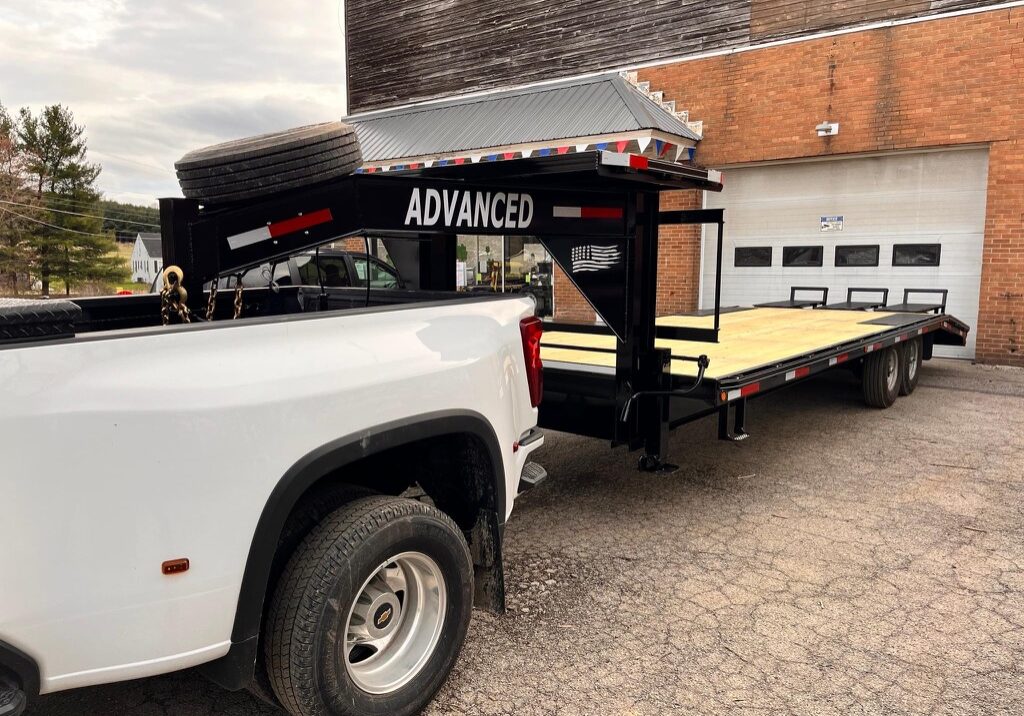
Gooseneck or Bumper Pull: Which Trailer is Best for You?
Trying to choose between a gooseneck or bumper pull trailer? This article explains the differences and helps you decide which is best for your needs.
Key Takeaways
- Bumper pull trailers are suitable for lighter loads and are easier to use, making them ideal for first-time trailer owners.
- Gooseneck trailers, with their higher weight capacity and better stability, are preferred for heavy-duty hauling and commercial applications.
- Choosing the right trailer requires assessing your towing vehicle’s capacity and your specific hauling needs to determine which type best fits your requirements.
Understanding Trailer Types
When it comes to towing, two primary trailer types dominate the market: bumper pull and gooseneck trailers. These two options differ significantly in their hitching systems, design, and functionality, each offering unique benefits and challenges.
These differences play a significant role in choosing the appropriate trailer for your needs.
What is a Bumper Pull Trailer?
A bumper pull trailer connects to a tow vehicle via a ball hitch on the rear frame, a common setup that makes these trailers popular for light to medium-duty hauling. The trailer’s tongue fits onto the ball hitch, which is typically mounted on the tow vehicle’s bumper. First-time trailer owners and those with limited trailering experience often favor this straightforward connection method. Bumper pull trailers are generally smaller and use a standard ball hitch, which means they can be towed by a wide variety of vehicles, including most pickup trucks and SUVs. The trailer’s tongue fits securely, ensuring a stable towing experience.
Its simplicity allows for easy attachment and detachment, making it convenient for those who frequently switch between towing and non-towing activities. These trailers are particularly suitable for lighter loads, such as small boats, motorcycles, or garden equipment.
However, their maximum towing capacity is generally lower compared to gooseneck trailers, which can limit their use for heavier or more demanding hauls.
What is a Gooseneck Trailer?
A gooseneck trailer is designed to be towed by a pickup truck, utilizing a hitch system that is installed in the truck bed rather than on the vehicle’s bumper. The gooseneck hitch is located beneath the truck bed, directly above the rear axle, which provides a more stable and secure connection than a bumper pull hitch. Installing a gooseneck hitch is a more involved process compared to the simpler bumper pull hitch setup.
The design of a gooseneck trailer features a long, arched neck that extends over the truck bed, allowing for better weight distribution and enhanced towing stability. This design makes gooseneck trailers ideal for heavy-duty applications, such as hauling large livestock trailers, heavy machinery, or bulky loads that exceed the capabilities of bumper pull trailers, including the use of a gooseneck ball.
Additionally, the gooseneck hitch system allows for tighter turns and improved maneuverability, making these trailers a preferred choice for experienced towers and commercial use.
Key Differences Between Bumper Pull and Gooseneck Trailers
When choosing between a bumper pull and a gooseneck trailer, it’s essential to understand the key differences in their design, functionality, and suitability for various towing tasks. These differences can significantly impact your decision, depending on your specific hauling needs and preferences.
The primary distinctions between these two trailer types include hitching mechanisms, size and capacity, and towing stability.
Hitching Mechanism
The hitching mechanism is one of the most fundamental differences between bumper pull and gooseneck trailers. Bumper pull trailers connect to the tow vehicle’s rear frame using a ball hitch, which makes them easy to attach and detach. Being user-friendly, this hitch can be managed without much hassle since it is visible from the driver’s seat during attachment. This simplicity benefits those with limited trailering experience or first-time trailer owners.
Gooseneck trailers use a more complex hitching system. This system is installed in the truck bed. The gooseneck hitch is mounted above the truck’s rear axle, providing a more stable and secure connection. Although this setup provides enhanced stability, it demands more effort and precision during installation and attachment. Gooseneck hitches are essential for this type of trailer.
This hitching mechanism is beneficial for heavy-duty hauling, as it distributes the weight more evenly across the vehicle’s frame, reducing sway and improving overall towing performance with a fifth wheel hitch and a hinged plate hitch.
Size and Capacity
The size and capacity of the trailer are crucial factors to consider when deciding between a bumper pull and a gooseneck trailer. Gooseneck trailers can handle larger and heavier loads, often exceeding 30,000 pounds, making them ideal for heavy-duty applications such as transporting heavy machinery or livestock. Their design allows for better weight distribution over the truck’s rear axle, which enhances their towing capabilities and stability.
On the other hand, bumper pull trailers are generally limited in size and capacity, with a maximum load capacity significantly lower than that of gooseneck trailers. This limitation makes bumper pull trailers more suitable for lighter hauling needs, such as small boats, recreational vehicles, or garden equipment.
Knowing the specific weight and dimensions of your cargo helps determine which trailer type will best meet your needs.
Towing Stability
Towing stability is a critical consideration for anyone planning to haul heavy loads over long distances. Bumper pull trailers often struggle with maintaining stability, especially when towing heavier or unbalanced loads. They are more susceptible to sway and instability, particularly at higher speeds or during sharp turns, and this can be exacerbated by uneven terrain or windy conditions.
In contrast, the design of gooseneck trailers provides superior stability due to better weight distribution and a lower center of gravity. The gooseneck hitch configuration reduces sway and offers a smoother pull, making these trailers more stable and safer to tow, especially with heavier loads. This stability makes gooseneck trailers a preferred choice for long-distance towing and commercial hauling.
Advantages of Bumper Pull Trailers
Bumper pull trailers offer several advantages that make them a popular choice for a wide range of users. These benefits include cost-effectiveness, ease of use, and versatility, making them suitable for both recreational and commercial purposes. These advantages can be explored in more detail.
Cost-Effectiveness
One of the primary advantages of bumper pull trailers is their cost-effectiveness. These trailers are generally more affordable to purchase and maintain compared to gooseneck trailers, making them an appealing choice for first-time users and those on a budget.
Bumper pull trailers are also better suited for lighter loads, which often means lower overall costs for towing and maintenance. Bumper pulls are a practical choice for many.
Ease of Use
Bumper pull trailers are known for their ease of use, making them a popular choice for casual users and first-time buyers. They connect to the tow vehicle’s bumper via a ball hitch, which simplifies the attachment and detachment process. This straightforward hitching mechanism allows for greater maneuverability and ease of handling, especially in tight spaces.
Additionally, bumper pull trailers are versatile, capable of transporting various types of cargo, including horses, boats, and recreational vehicles. Their design results in a smoother pull and better towing stability with light-duty vehicles. This versatility and ease of use make bumper pull trailers a convenient and flexible option for many towing needs.
Versatility
The versatility of bumper pull trailers is another significant advantage. These trailers can accommodate a wide range of cargo types, making them suitable for both recreational and commercial purposes. Whether you’re hauling toys and equipment for a weekend adventure or carrying materials for your business, a bumper pull trailer can handle the job.
Their adaptability enhances their appeal to a broad audience, from hobbyists to professionals. This versatility, combined with their cost-effectiveness and ease of use, makes bumper pull trailers a practical choice for many towing applications.
Advantages of Gooseneck Trailers
Gooseneck trailers offer several advantages that make them a preferred choice for heavy-duty hauling and commercial use. These benefits include higher weight capacity, better maneuverability, and enhanced stability, which are crucial for demanding towing tasks.
These advantages can be explored further.
Higher Weight Capacity
Gooseneck trailers are renowned for their higher weight capacity, making them ideal for transporting heavy loads over long distances. These trailers can handle loads exceeding 30,000 pounds, thanks to their robust design and better load distribution across the truck’s frame.
This capability makes gooseneck trailers suitable for commercial use and heavy-duty applications, such as hauling heavy machinery or livestock.
Better Maneuverability
The design of gooseneck trailers allows for better maneuverability, especially in tight spaces. Their closer connection to the towing vehicle provides a tighter turn radius, making it easier to navigate through constrained areas. This enhanced maneuverability is particularly beneficial for experienced towers and those who frequently need to make sharp turns or navigate through crowded areas.
Enhanced Stability
Gooseneck trailers also offer enhanced stability, which is crucial for safe and efficient towing. Their design reduces the likelihood of swaying during transport, providing a smoother pull and a better ride. Additionally, gooseneck trailer slides can further improve the towing experience.
This stability is crucial for long-distance towing and carrying heavy loads, ensuring a safer and more comfortable journey.
Disadvantages of Bumper Pull Trailers
While bumper pull trailers have many advantages, they also come with certain limitations. These disadvantages include limited load capacity and stability concerns, which can impact their suitability for heavy-duty hauling tasks.
These drawbacks can be examined in more detail.
Limited Load Capacity
One of the main disadvantages of bumper pull trailers is their limited load capacity. These trailers typically have a maximum towing capacity of around 20,000 pounds, with a combined weight limit of 10,001 pounds for the trailer and the towing vehicle.
This restriction makes them less suitable for transporting heavy loads compared to gooseneck trailers.
Stability Concerns
Another significant disadvantage of bumper pull trailers is their reduced towing stability, especially when carrying heavier loads. Their hitching mechanism and design can lead to instability, particularly on rough terrain or during sharp turns, increasing the risk of sway and making them less safe for heavy-duty hauling.
In contrast, gooseneck trailers offer better stability, making them a preferred choice for those needing to transport heavier loads over longer distances.
Disadvantages of Gooseneck Trailers
Gooseneck trailers, while offering significant advantages, also have certain disadvantages. These include higher costs and space requirements, which can pose challenges for some users.
Let’s explore these drawbacks in more detail.
Higher Costs
The most notable disadvantage of gooseneck trailers is their higher upfront cost. Purchasing a gooseneck trailer involves a significant investment, including the cost of the trailer itself and the installation of the required hitch in the truck bed. This higher cost can be a barrier for some users, particularly those looking for a more budget-friendly option.
Space Requirements
Installing a gooseneck hitch in a pickup truck bed significantly reduces the available space for other uses. The specialized hitch occupies a substantial portion of the truck bed, limiting the vehicle’s versatility and storage capacity.
This space requirement can be a disadvantage for users who need to maximize the utility of their truck bed for various purposes.
Choosing the Right Trailer for Your Needs
Selecting the right trailer involves considering your towing vehicle’s capacity and your specific hauling needs. Both bumper pull and gooseneck trailers have their unique advantages and disadvantages, and the best choice depends on your individual requirements and preferences.
Assessing your tow vehicle’s towing vehicle and hauling needs helps in making the right decision.
Assessing Your Towing Vehicle
Ensuring your towing vehicle has the necessary capacity and compatibility for either a bumper pull or gooseneck trailer is crucial. The towing capacity of your vehicle dictates the maximum weight you can safely tow, which is essential for selecting the appropriate trailer type.
Knowing your vehicle’s specifications and confirming it can handle the weight of the trailer and its cargo is essential for safe and efficient towing.
Evaluating Hauling Needs
The type and volume of cargo you intend to transport should guide your decision on which trailer type to choose. Bumper pull trailers are versatile and can efficiently transport a wide range of cargo, including light equipment and recreational vehicles.
However, if you need to haul heavier loads or specialized cargo such as livestock, a gooseneck trailer may be more suitable due to its higher weight capacity and enhanced stability.
Summary
Choosing the right trailer is a critical decision that depends on your specific towing needs and vehicle capabilities. Bumper pull trailers offer cost-effectiveness, ease of use, and versatility, making them ideal for lighter loads and first-time users. In contrast, gooseneck trailers provide higher weight capacity, better maneuverability, and enhanced stability, suitable for heavy-duty and commercial applications. By carefully assessing your towing vehicle and hauling requirements, you can select the trailer that best meets your needs and ensures a safe and efficient towing experience.
Frequently Asked Questions
What are the cons of a gooseneck trailer?
The primary disadvantages of a gooseneck trailer include the higher cost and the reduction of pickup bed space when the trailer is attached. These factors may be important to consider for individuals balancing budget and utility.
Is gooseneck better than bumper pull?
Gooseneck trailers are generally considered better than bumper pulls due to their superior load balance and stability, allowing for tighter turns with less swaying. For these reasons, goosenecks may provide a more secure towing experience.
What is the main difference between bumper pull and gooseneck trailers?
The main difference between bumper pull and gooseneck trailers lies in their hitching systems: bumper pull trailers connect to the rear frame of the vehicle, whereas gooseneck trailers attach to a hitch located in the truck bed. This distinction affects stability, towing capacity, and maneuverability.
Which trailer type is more stable for towing?
Gooseneck trailers are more stable for towing due to their design and weight distribution, providing improved control on the road.
Are bumper pull trailers more affordable?
Bumper pull trailers are generally more affordable and require less maintenance, making them a cost-effective choice.
EXPLORE MORE
RELATED ARTICLES
Best Flat Bed Trailers for Sale | Top Deals to Enhance Your Hauling
Need a flatbed trailer for your hauling needs? This article will guide you through the types, features, and considerations for choosing the right trailers flat bed. Learn what to look for and make an informed choice. Key Takeaways Explore Our Range of Flatbed Trailers Our comprehensive selection of flatbed trailers…
Read More...Gooseneck or Bumper Pull: Which Trailer is Best for You?
Trying to choose between a gooseneck or bumper pull trailer? This article explains the differences and helps you decide which is best for your needs. Key Takeaways Understanding Trailer Types When it comes to towing, two primary trailer types dominate the market: bumper pull and gooseneck trailers. These two options…
Read More...Top Dual Tandem Trailer Options for Heavy-Duty Hauling
Searching for a trailer that can handle heavy-duty loads? Look no further than a dual tandem trailer. Known for their stability and durability, dual tandem trailers are built to manage the most demanding hauling tasks. In this article, we’ll cover what makes these trailers stand out, key features to look…
Read More...Top 10k Gooseneck Trailer Options for Heavy-Duty Hauling
Searching for the best 10k gooseneck trailer for heavy-duty hauling? This article covers top options, essential features, and what to consider when choosing the right trailer. Get ready to find out which models can handle your toughest tasks efficiently. Key Takeaways 10k Gooseneck Trailer Overview 10k gooseneck trailers are renowned…
Read More...Top Flat Deck Trailer Options | Best Deals & Features
Flat deck trailers are perfect for hauling oversized or heavy loads. They transport construction materials, vehicles, and other large items efficiently. This guide explores top flat deck trailer options, key features, and how to choose the right one for your needs. Key Takeaways Discover the Best Flat Deck Trailers Flatbed…
Read More...Top Picks for Your Custom Built Trailer Needs
Looking for a trailer that fits your specific needs? A custom built trailer might be the answer. In this article, you’ll learn the benefits of custom trailers, explore various customization options, and discover different types available. See how a custom trailer can meet your needs perfectly. Key Takeaways Why Choose…
Read More...Flat Trailer Solutions Built For The Long Haul
A flat trailer offers a reliable way to transport large, heavy loads. This article covers what flat trailers are, their benefits, and available options to help you choose the best one for your needs. Key Takeaways High-Quality Flatbed Trailers for All Your Hauling Needs Built with reliable and durable parts,…
Read More...Top-Rated Gooseneck Flatbed Trailer Options for Your Hauling Needs
Top-Rated Gooseneck Flatbed Trailer Options for Your Hauling Needs A gooseneck flatbed trailer excels at heavy-duty hauling, offering superior stability by attaching to the truck bed. Ideal for transporting equipment or livestock, this guide covers top-rated options, key features, and tips for choosing the right model. Key Takeaways Gooseneck flatbed…
Read More...